Hard Hat Expiration: How Long Are Hard Hats Good For?
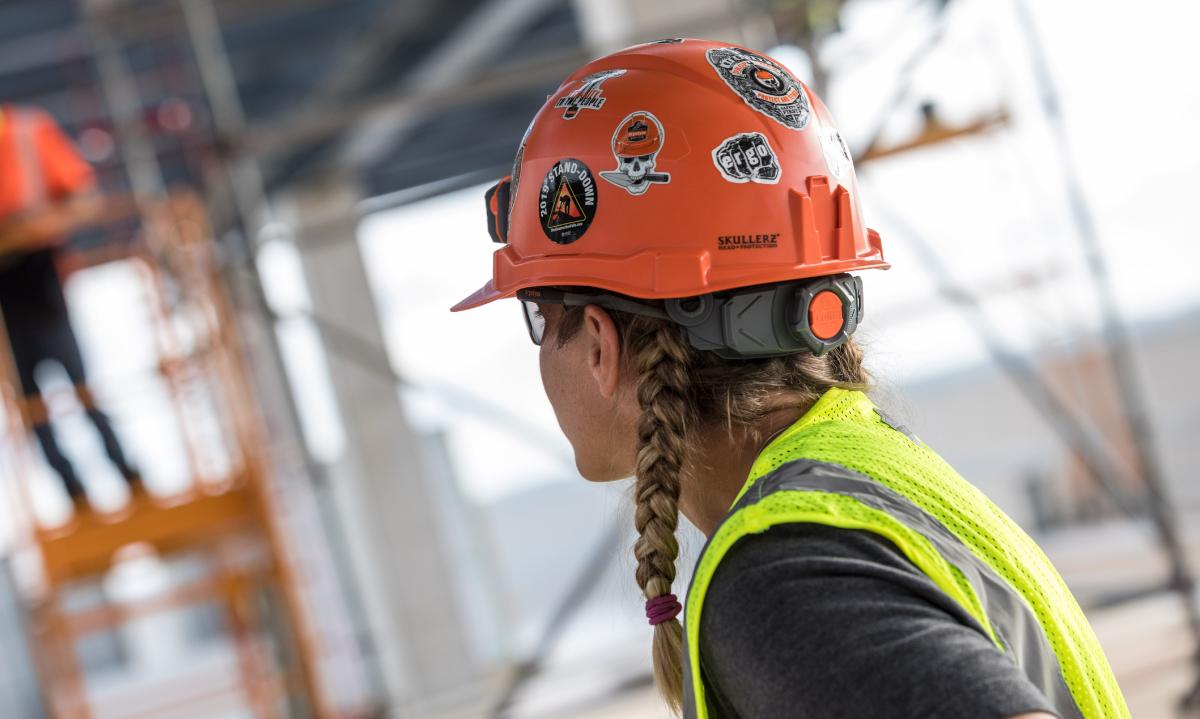
Before you say anything, we get it. Hard hats are a badge of honor. It’s your battle-scarred, sticker-loaded representation of long hours on unforgiving job sites. But when it comes to protecting your most valuable asset, how much faith should you put in ‘ol faithful before bidding a teary goodbye and swapping it out for a new one?
Unfortunately, when it comes to guarding your gray matter, the recommendations on hard hat expiration can be just that—gray. That’s why we did our best to break it down before your hard hat does.
Psst… all of the following also applies to safety helmets.
HARD HAT EXPIRATION & REPLACEMENT
Are there OSHA hard hat expiration Requirements?
While OSHA does require that all hard hats comply with the ANSI/ISEA Z89.1-2014 standard for Industrial Head Protection, they do not explicitly state anything about hard hat expiration. That said, as personal protective equipment (PPE), hard hats do fall under OSHA’s General Duty Clause. This requires that employers provide and mandate the use of reliable, properly functioning PPE. If the PPE is defective or damaged (say, a hard hat that’s been banged up on the job for the past decade), employers are required to replace it.
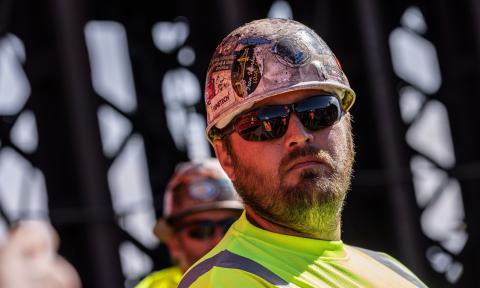
What do hard hat standards say about hard hat expiration?
ANSI/ISEA Z89.1-2014 & CSA Z94.1
ANSI/ISEA Z89.1-2014 and CSA Z94.1, which set the U.S. and Canadian testing requirements for hard hats and safety helmets, also do not explicitly address hard hat expiration. The standards instead mandate inspection before and after each use (with replacement upon sign of damage), as well as strict observation of the instructions, warnings, precautions, limitations and cleaning instructions set by the manufacturer. ANSI Z89.1 does require that each hard hat have permanent markings. That marking must include the following information:
- Manufacturer name
- Date of manufacture
- ANSI/ISEA Z89.1 designation
- Hard hat type and class designations with applicable criteria markings
- Approximate headsize range
- Markings indicating optional performance features, including reverse donning (symbol), lower temperature (LT), higher temperature (HT) and high visibility (HV)
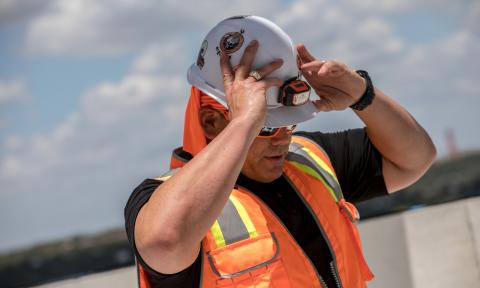
EN 397
EN 397, the European Standard for hard hats and safety helmets, is similar to the American and Canadian standards in that it does not call out hard hat expiration. However, unlike the American standard, it does require the passing of an artificial aging test for certification. This accelerated UV test uses a xenon arc lamp to expose the helmet to radiation to ensure it will continue to provide adequate protection in sunlight over time.
When do hard hats expire?
If you only read one thing in this entire blog, let it be this. If your hard hat has knowingly sustained any significant impact or penetration, it needs to be replaced immediately. No ifs, ands or buts.
Given all of the ambiguous non-answer answers above, the best—and safest—practice for hard hat replacement is to always follow specific manufacturer replacement guidelines. Under ANSI/ISEA Z89.1-2014, manufacturers must include guidelines for care and useful service life. And while the standard does not require them to define specific service life in terms of number of years, most do.
The most common service life guideline states that hard hat shells need to be replaced after no more than two years of regular use or five years from the date of manufacture—whichever comes first. The life for suspensions is shorter, with replacement needed after no more than twelve months.
How to Decode a Hard Hat Date Code
To determine the specific replacement date for your hard hat, you’ll need to reference the date of manufacture (usually located on the interior of the helmet). Though the date code may be marked in a variety of ways, it is most common for manufacturers to use a date wheel. These clock-looking codes are universal across all hard hats and safety helmets, with the number in the middle signaling the year of manufacture and the arrow pointing to the number signaling the month.
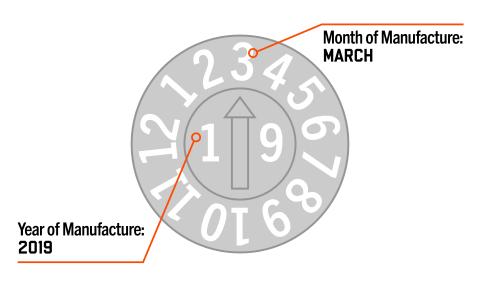
HARD HAT INSPECTION
While manufacturer dates provide a hard stop on hard hat life, they are far from the only factor to be considered. Depending on the job site environment (if someone is working in direct sunlight, for example), hard hats may need to be replaced much sooner. That’s why regular inspection is so important.
How often should hard hats be inspected?
According to ANSI, CSA and EN standards, hard hats—including the shell and suspension—must be inspected before and after each use.
What should you look for while inspecting a hard hat?
Check the hard hat shell and suspension for any cracks, breakage, discoloration, damaged stitching or any other damage, excessive wear or unusual condition. Any of these conditions can indicate reduced impact or penetration resistance, meaning the hard hat should be replaced immediately.
Another quick test you can conduct to gauge your hard hat's effectiveness is to flex the brim to see if it has become brittle or hard, or if it still has some flex. To get an accurate sense of what the flex should feel like, first run the same test on a new hard hat.
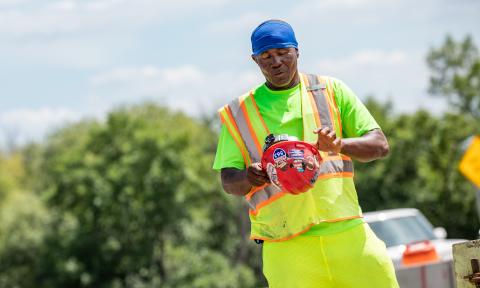
HOW TO EXTEND THE LIFE OF YOUR HARD HAT
Now, much of the wear and tear sustained by a hard hat is unavoidable—it just comes with the territory of working on a jobsite. But there are some things you can do (or, perhaps more accurately, not do) to make sure your hard hat stays in tip top shape:
- Never alter, puncture, modify or engrave the shell or suspension
- Do not use paints, solvents, chemicals, adhesives or gasolines on the hard hat
- Do not store objects between the suspension and the shell
- Always clean hard hats and suspensions with mild soap and water—harsh solvents and chemicals found in cleaners can degrade the shell
- Whenever possible, store hard hats in a cool place away from direct sunlight (this is where gear bags with built-in hard hat storage come in handy)
TRADE UP TO SKULLERZ
Unlike our undying love for safety, hard hats weren’t made to last forever. If your trusty old bucket has been battling it out with you in the trenches for the better half of decade or longer, it’s time to let it enjoy a much deserved retirement. Skullerz is ready when you are.
UPGRADE TO THE NEXT GENERATION OF HEAD PROTECTION >>>
FAQ
Most manufacturers recommend replacing the shell every 5 years and the suspension every 12 months, even if there are no visible signs of damage. Heat, sun, and harsh environments can shorten that lifespan.
Look for the date stamp inside the shell. It’s usually a circle with a year in the middle and numbers 1–12 around it (like a clock). The arrow points to the month of manufacture. From that date, you can count forward to estimate the recommended service life (commonly 5 years).
A hard hat is considered expired if it’s past the manufacturer’s recommended lifespan (from the date of manufacture or first use) or if it shows signs of damage like cracks, fading, brittleness, chalky texture, or worn suspension straps.
At a minimum, replace the suspension every year and the shell every 5 years. However, replace immediately if the hard hat has been hit, dropped, or shows visible damage. Safety should never wait for the calendar.
Even unused hard hats degrade over time. The clock starts from the manufacture date, not the first use. Store them away from sunlight, heat, and chemicals, but still plan to replace within the recommended 5 years.

